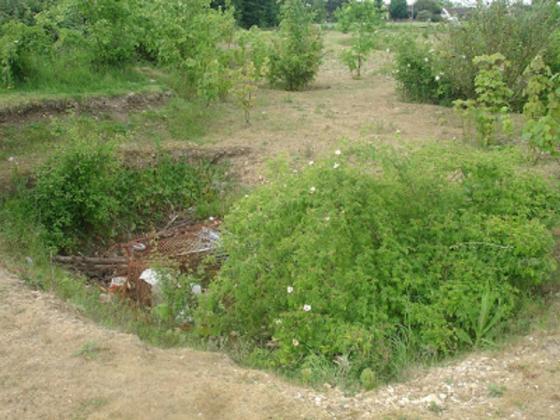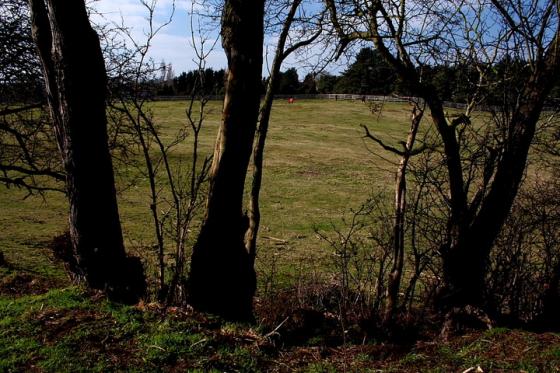
Danbury from the south....... sure, there’s not a great deal left, but sometimes minimalism has an awful lot to say.

Danbury from the south....... sure, there’s not a great deal left, but sometimes minimalism has an awful lot to say.

Approaching uphill from the south... not a bad defensive position. For Essex. The most recognisable remains of the bank are to be found in the trees to the left of the prominent (white) water tower.

To the north-west. A brief shaft of light penetrates the darkness which envelopes Danbury’s Iron Age past... in more ways than one.

Forcing my way through the undergrowth for a glimpse of what remains of the north-western arc.

Ramparts turned into a dump for allotment residue. Nice one, gardeners of Danbury. South-west arc.

Looking southwards across Essex. Aye, it’s true. This was a hillfort.

Within the Iron Age enclosure, looking north... although not ancient, these stones mean an awful lot to some...

Looking south.... wonder if they would have had allotments within the Iron Age enclosure?

The scant remains upon the western flank...... I think. Hard to tell without an industrial strimmer...

The 13th century church of St John the Baptist stands inside the enclosure. Never envisaged posting an image of one of these, but if they insist on building them within Iron Age hillforts...

A section – I think – of remaining rampart to approx south-east (ish)....

Approaching from The Cricketer’s Arms to the south. The surviving ramparts are within the trees to left of the prominent white water tank, curving up to the north along the western flank... very difficult to make out anything at all upon the eastern and northern arcs.

Viewed from the south-west across Paternoster Farm – the church spire and antennae define the enclosure. The crows define the sky.

From a distance.... looking from the approx south-west. The warm glow of evening.... although not exactly warm!
A trip to Danbury.... not much left, but there you are.
Strange one, this.... although Danbury Camp overlooks the ‘Sunday walking’ route I’ve undertaken for the best part of two decades – when not otherwise engaged somewhere else in these Isles, of course – I’ve only actually visited the site upon a couple of occasions.
I guess the most obvious reason for this is the paucity of visible prehistoric remains. Or at least of the kind that didn’t need digging up by your friendly local archeaologist. There are no impressive, free standing ramparts left to walk around, or sit upon looking south-westwards towards Hanningfield Reservoir... just a few, barely identifiable remnants of tree-cloaked earthwork running from north-west to south-west backing onto residents’ gardens... I think. Hey, even the information panel by the church entrance has rotted away to oblivion. However this is not to say that this former Iron Age enclosure is empty. Oh no. Far from it. The 13th Century church of St. John the Baptist is the most obvious Johnny-come-lately (ha!) with attendant graveyard and garden allotments providing a rather peculiar juxtaposition of ‘life and death’, if the truth be told. A water tank/tower and, last and definately least, a large antennae add to the general confusion.
Today only a few locals taking shortcuts break the silence and disturb the pristine white blanket of snow.... seeing as the expected multitude of children sledging down the hillside are simply nowhere to be seen. What is it with kids nowadays? Yeah, in conditions such as this the old hillfort still retains echoes of its ancient past, if somewhat uncomfortably in the literal shadow of such an impressive Christian edifice.
I retrace my steps back down to road by The Cricketer’s Arms and continue on my way – without pausing to sample anything, you understand. The landscape can look no better than it does today under this brilliant winter sun slowly sinking to the horizon, trees a firey combination of orange and red, the fields a mantle of glistening white. As I cut through Danbury Lakes on the way back to the car, the sun’s rays reflecting off the frozen water and silhouetting a moorhen standing somewhat confused mid-lake, I’m suddenly chuffed to bits that Danbury Camp is still clinging to existance upon the overlooking hill. The nearby ‘palace’ may be a conference centre now, but somehow the ancient hillfort adds a sense of substantiality to being here. Funny, isn’t it?
A village grew up inside this hillfort, including the church of St John the Baptist. In 1402 the Devil appeared in the church during a terrible thunderstorm, taking on the form of a grey friar and ‘behaving himself verie outrageouslie’ according to Holinshed’s Chronicles (written in the 16th century). The nave and a part of the chancel were destroyed. Cynics will put this down to the relative height of church, the fort being the highest point in Essex, and thus vulnerable to lightning and eldritch storms, rather than to any devilish qualities of the fort itself.
Mentioned in Westwood and Simpson’s ‘Lore of the Land’ (2005) p255.
It seems to be originally in Thomas Walsingham’s ‘Historia Anglicana’, written at about the time the event is supposed to have happened? You can see it here, and if you put the latin into google translate (I’m afraid my latin talents won’t run to it otherwise), you will hear about Unspeakable Terror of the parishioners and flashing globes of lightning.
Having been part of my ‘Sunday walking’ landscape for the past 20 years, or so, I’d love to be able to report that this is an essential visit. Sadly this is not the case, however. Although the defences of this plateau hillfort – consisting apparently of single rampart and ditch – can still, for the most part, be traced, all but the most enthusiastic visitor will no doubt leave disappointed. The most prominent feature of the site – discounting the large antennae mast nearby, that is – is the 13th Century Church of St. John the Baptist. Great if you like that sort of thing, I guess.
Excavations have revealed evidence of Iron Age occupation; however the name Danbury seems to relate to the Saxon ‘Daeningas’ tribe. Fair enough. The ‘fort now echoes – if that’s the right word – to the shouts of local sportsmen on the nearby playing fields at weekends. At other times it is quiet save the occasional walker or gardener tending the allotments within the enclosure.
In summary, then, worth a look if you’re in the area, but don’t arrive expecting to be awed by mighty ramparts........










